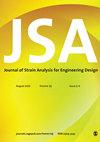Analytical modeling of through depth strain induced by deep rolling
IF 1.8
4区 工程技术
Q3 ENGINEERING, MECHANICAL
Journal of Strain Analysis for Engineering Design
Pub Date : 2021-06-16
DOI:10.1177/03093247211027081
引用次数: 0
Abstract
The material properties of the surface layer caused by deep rolling are closely related to the degree of strain hardening. It is of great significance to establish the prediction model of strain distribution to realize the surface strain control and improve the service performance of deep rolling parts. In this study, the analytical models of elastic-plastic strain based on the Hertz contact theory were established by two different methods. The accuracy of the analytical prediction model of elastic-plastic strain was examined by deep rolling simulation. Then, the influence of deep rolling parameters, such as rolling force, the ball diameter, and material on the elastic-plastic strain along the depth was studied and validated by the microhardness profiles along the depth. The results indicate that the analytical model established by the first method is more accurate, and the error between maximum elastic-plastic strain obtained by the first method and finite element (FE) simulation is 12.6%. The elastic-plastic strain along the depth increases with the increasing rolling force and decreases with the increasing ball diameter, and its effective depth increases with the increasing rolling force. The tungsten carbide ball generates more elastic-plastic strain than balls of the other two materials (silicon nitride and steel). In addition, the elastic-plastic strain profiles are in accordance with the change of microhardness along the depth. In a word, the model can be used to predict the strain distribution along the depth induced by deep rolling.深轧引起的纵深应变解析建模
深轧引起的表层材料性能与应变硬化程度密切相关。建立应变分布预测模型,对实现深轧件表面应变控制,提高零件的使用性能具有重要意义。本文采用两种不同的方法建立了基于赫兹接触理论的弹塑性应变解析模型。通过深轧仿真验证了弹塑性应变解析预测模型的准确性。然后,研究了轧制力、球直径和材料等深滚参数对深滚过程弹塑性应变的影响,并通过深滚过程显微硬度曲线进行了验证。结果表明,采用第一种方法建立的解析模型更为精确,得到的最大弹塑性应变与有限元模拟的误差为12.6%。沿深度的弹塑性应变随轧制力的增大而增大,随球径的增大而减小,有效深度随轧制力的增大而增大。碳化钨球比其他两种材料(氮化硅和钢)球产生更大的弹塑性应变。此外,弹塑性应变曲线与显微硬度沿深度的变化一致。总之,该模型可用于预测深轧引起的应变沿深度分布。
本文章由计算机程序翻译,如有差异,请以英文原文为准。
求助全文
约1分钟内获得全文
求助全文
来源期刊

Journal of Strain Analysis for Engineering Design
工程技术-材料科学:表征与测试
CiteScore
3.50
自引率
6.20%
发文量
25
审稿时长
>12 weeks
期刊介绍:
The Journal of Strain Analysis for Engineering Design provides a forum for work relating to the measurement and analysis of strain that is appropriate to engineering design and practice.
"Since launching in 1965, The Journal of Strain Analysis has been a collegiate effort, dedicated to providing exemplary service to our authors. We welcome contributions related to analytical, experimental, and numerical techniques for the analysis and/or measurement of stress and/or strain, or studies of relevant material properties and failure modes. Our international Editorial Board contains experts in all of these fields and is keen to encourage papers on novel techniques and innovative applications." Professor Eann Patterson - University of Liverpool, UK
This journal is a member of the Committee on Publication Ethics (COPE).
 求助内容:
求助内容: 应助结果提醒方式:
应助结果提醒方式:


